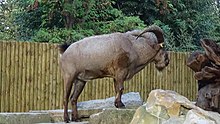The West Caucasian tur (Capra caucasica) is a mountain-dwelling goat-antelope native to the western half of the Caucasus Mountains range, in Georgia and European Russia. It is listed as Endangered on the IUCN Red List, as the wild population is estimated to be between 5,000 and 6,000 individuals.[1]
| West Caucasian tur | |
|---|---|

| |
| Scientific classification | |
| Domain: | Eukaryota |
| Kingdom: | Animalia |
| Phylum: | Chordata |
| Class: | Mammalia |
| Order: | Artiodactyla |
| Family: | Bovidae |
| Subfamily: | Caprinae |
| Tribe: | Caprini |
| Genus: | Capra |
| Species: |
C. caucasica
|
| Binomial name | |
| Capra caucasica Güldenstädt and Pallas, 1783 | |
It is also known by the names "zebuder," "zac" and "Caucasian ibex."[2][3]
West Caucasian turs stand up to 1 m (3.3 ft) tall at the shoulder and weigh around 65 kg (143 lb). They have large but narrow bodies and short legs. West Caucasian turs have a chestnut coat with a yellow underbelly and darker legs. Their horns are scimitar-shaped and heavily ridged. In males, these horns are around 70 cm (28 in), while in females they are much smaller.
West Caucasian turs live in rough mountainous terrain between 800 and 4,000 m (2,600 and 13,100 ft) above sea level, where they eat mainly grasses and leaves.
They are preyed upon by steppe wolves and lynxes; Persian leopards and Syrian brown bears may also be possible predators. Humans are also a risk due to hunting expeditions.
The West Caucasian tur is nocturnal, eating in the open at night, and sheltering during the day. Females live in herds of around 10 individuals, while males are solitary.
This article about an even-toed ungulate is a stub. You can help Wikipedia by expanding it. |